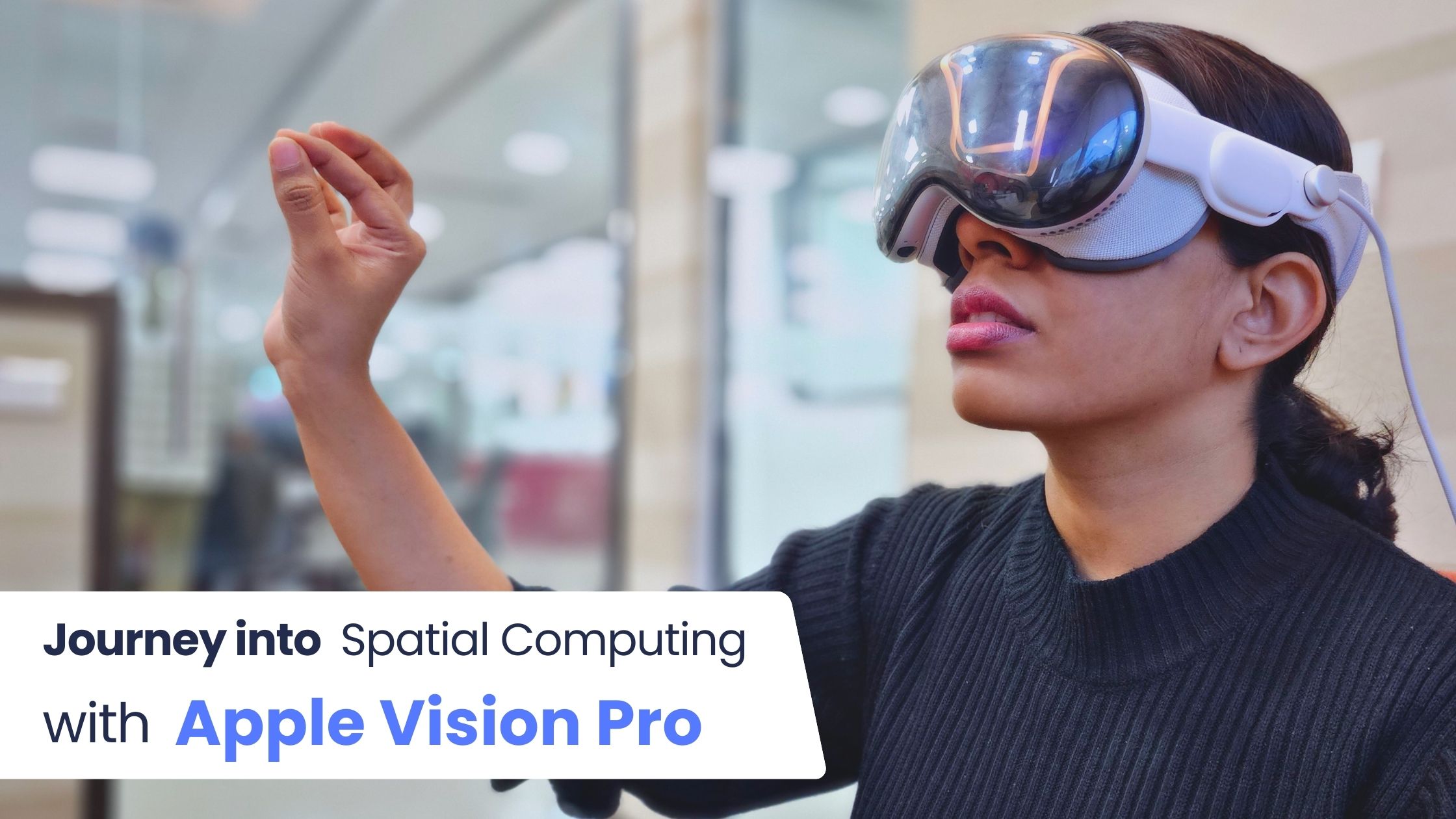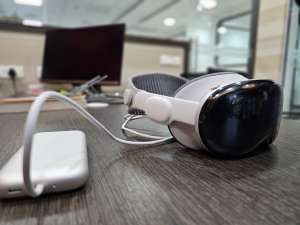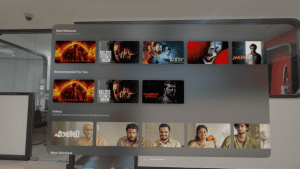March 11th, 2024
Category: Uncategorized
No Comments
Posted by: Team TA

After eagerly anticipating its arrival, our long-awaited moment to experience the latest Apple Vision Pro is finally over. As someone who deeply loves tech, trying out Vision Pro was nothing short of amazing. From its user-friendly design to its immersive experience, the apple vision pro into spatial computing has truly redefined what’s possible in the world of Virtual Reality.
apple vision pro into spatial computing
Join me as I take you through my exciting journey with this remarkable device and how it compares to its other virtual reality counterparts.
From the moment I laid eyes on the Vision Pro, its sleek design and premium build quality left an indelible impression. Having experienced several VR headsets available on the market, I can confidently say that this Apple VR product boasts the sharpest display I’ve ever encountered, thanks to its cutting-edge micro-LED technology. With individual display pixels measuring a mere seven and a half microns, the Vision Pro sets a new standard of visual fidelity that surpasses its competitors. Additionally, Apple’s inclusion of a 90 Hz refresh rate, which can be pushed up to an impressive 96 Hz, further enhances the device’s fluidity and responsiveness.
Let’s take a deep dive into the diverse range of aspects the Vision Pro presents, from its impressive features to aspects that shape its overall character and user experience, including any potential flaws.

-
Foveated Rendering
Revolutionizing Virtual Reality, the Apple Vision Pro introduces a groundbreaking technology known as foveated rendering. Unlike current technological limitations, Vision Pro pushes boundaries by boldly integrating advanced eye-tracking capabilities. With this innovative feature, the device accurately tracks the user’s eye movements in real-time. As users navigate through virtual environments, the display dynamically adjusts focus, rendering sharp details precisely where one is looking. And when the gaze shifts, the device seamlessly refocuses, creating a natural and immersive experience. This remarkable functionality ensures that the user is fully engaged with the content while conserving resources by softening peripheral areas of the screen. The result is an unparalleled level of visual precision and immersion, setting the Vision Pro apart from its competitors.
Another thing I often find myself caught in is being stuck in the loop with eye-tracking calibration, where I must stare at dots repeatedly, only for the next person to undergo the same routine all over again. It’s like a never-ending cycle. It would be amazing if Apple could introduce a profile-based approach for Vision Pro so that once and for all we can bid goodbye to the repetitive hassle of recalibration each time.
-
Battery & Immersive Performance
One noticeable feature of the Vision Pro is its tethered lithium-ion battery pack. Unlike current market-available batteries, the lithium-ion technology utilized in the Vision Pro promises faster charging, a longer lifespan, and increased power density, all packaged in a not-so-lightweight design connected via a cable to the headset. While this setup ensures prolonged usage without the hassle of frequent recharges, I found the external battery design to be somewhat cumbersome. The thought of carrying it around felt a bit awkward, especially when on the move. If I’m lounging on a couch or sofa, the battery pack’s presence isn’t much of an issue; however, it becomes challenging to maneuver in more dynamic environments.
Nevertheless, the Vision Pro’s built-in software and hardware systems adeptly manage performance to mitigate any adverse effects from battery aging or low charge levels. This translates to a seamless experience, whether I’m tackling demanding tasks or immersing myself in VR adventures. With its real-time control of power consumption, the Vision Pro ensures high-level performance while maintaining efficiency. Whether it’s longer app launch times, reduced wireless data throughput, or lower speaker volume, the Vision Pro effortlessly adapts to deliver optimal performance tailored to meet the user’s needs. Fundamentally, the Apple Vision Pro exemplifies innovation at its finest, seamlessly blending cutting-edge technology with intuitive design to redefine the standards of performance in the world of Virtual Reality.
Exploring the digital world with the Apple Vision Pro has been nothing less than amazing. This VR headset seamlessly blends together top-notch hardware and software, thanks to Apple’s M2 and R1 chips, along with a bunch of sensors, mics, and cameras. Whether I’m setting up my workspace or diving into thrilling videos and games, the Vision Pro blows me away with its amazing performance and spatial computing abilities. What really sets it apart are features like 180-degree high-resolution videos, spatial audio, and pass-through mode, which make me feel like I’m living in a whole new world. It’s like stepping into a dream, where the line between reality and fantasy blurs into one seamless experience.
-
Passthrough
Even though the Vision Pro boasts impressive capabilities such as spatial audio and super immersive visuals, the implementation of the Eyesight gimmick left me doubting its true value. The placement of the passthrough cameras, coupled with optical distortion from curved glass, posed challenges that hindered rather than improved my experience. As I go through virtual landscapes, I can’t shake off the feeling of unease caused by misaligned cameras and the potential strain on my visual system. It became proof that the decision-making process behind the inclusion of EyeSight lacked a nuanced understanding of people’s needs and technical constraints. Despite these flaws, the Vision Pro is still a strong player in immersive technology. It’s cool features give us a taste of what Mixed Reality could be like in the future. But as someone who’s used it, I think we need to focus more on making things work well instead of adding flashy stuff.
-
Ecosystem
Having immersed myself in the Apple Vision Pro ecosystem, I must say, it is undeniably impressive. The built-in apps like Safari and the App Store work seamlessly with the device, making it easy to navigate and find what I need. FaceTime on the Vision Pro takes things to a whole new level—the virtual avatar it creates for me is super similar to the real deal.
Apple also offers a dedicated set of about 1000 apps specifically designed for the Vision Pro, which adds extra immersive effects to the experience. However, there’s a minor hiccup with the absence of dedicated apps like YouTube, Netflix, etc. It would be great to have these familiar apps optimized for the Vision Pro, but hopefully, that’s something Apple will address in future updates. Overall, the Apple Vision Pro ecosystem enhances the device’s capabilities, offering a wide range of features and possibilities. While there’s room for improvement, the experience so far has been pretty fantastic.
-
Comfortability & Weight
When it comes to weight, it’s worth noting that the Vision Pro is a bit heavier compared to other VR headsets on the market. While the average weight of VR headsets is around 500 grams, the Vision Pro comes in at about 650 grams, which is roughly 25% more. This extra weight can be noticeable, especially during longer sessions. While some users may not find it bothersome, others may notice the difference, especially if they’re accustomed to lighter headsets.
As for comfort, I initially struggled with the first-choice back strap provided by the company. Wearing the device for extended periods became uncomfortable due to the tightness of the strap. However, the Vision Pro offers a second strap option that resolved this issue for me. Switching to the alternative strap made a significant difference, allowing me to wear the headset comfortably for longer periods without experiencing discomfort. While the weight and initial comfort may pose challenges, the Vision Pro’s alternative strap option provides a solution, ensuring a more enjoyable experience for users.
Long story short
As I draw the curtain on my adventures with the Apple Vision Pro, it is both fascinating and admittedly flawed in some aspects. Nonetheless, it stands as a testament to the unparalleled quality and innovation that Apple brings to the table when we compare it to other VR products on the market. It’s evident that this device is a game-changer in the world of immersive technology. While it introduces cutting-edge features like the micro-LED display and advanced AI, there are also some challenges to consider. First is its tethered external battery pack, which not only adds weight and restricts users but is also very inconvenient for those who prioritize freedom of movement. Another is its slightly heavier weight, and initial discomfort with the first strap choice might deter some users, but the availability of an alternative strap provides a solution. Despite these initial hurdles, Vision Pro offers an exciting glimpse into the future of Mixed Reality experiences. With further refinement focused on user comfort and functionality, the Vision Pro has the potential to redefine the way we interact with technology. As a user, I’m eager to see how future iterations of Vision Pro continue to innovate and shape the landscape of immersive technology.
Introducing Vision Pro at TA

At Travancore Analytics (TA), we are dedicated to pushing boundaries, and we are proud to unveil our latest endeavors leveraging Apple Vision Pro.
In the realm of entertainment, we have developed an OTT platform equipped with high-quality 3D spatial video support, tailored for seamless viewing for Apple Vision Pro.

Secondly, we’ve developed an immersive Airport Twin platform specifically optimized for the Vision Pro environment, leveraging our TwinVerse Digital Twin Solution Accelerator. This innovative tool offers Vision Pro users a detailed and dynamic 3D visualization of San Francisco International Airport, complete with real-time flight positions and interactive features for easy tracking and access to flight details. With tailored 3D models and intuitive interface design, users can seamlessly engage with the airport’s operations and stay informed about arrivals, departures, and flight statuses directly from their Vision Pro devices.
At TA, we’re committed to leveraging Apple Vision Pro technology to enhance the way users engage with entertainment, education, training, and beyond. Connect with us to learn more!
Welcome to the future of Spatial Computing!